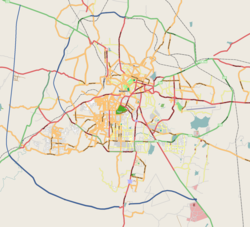This article possibly contains original research .(May 2024) |
Bengaluru Central Business District | |
|---|---|
Central Part of Bengaluru | |
| Coordinates: 12°58′30″N77°36′36″E / 12.975°N 77.61°E | |
| Country | |
| State | Karnataka |
| District | Bangalore Urban |
| City | Bengaluru |
| Government | |
| • Type | Municipal Corporation |
| • Body | BBMP |
| Languages | |
| • Official | Kannada English |
| Time zone | UTC+5:30 (IST) |
| PIN | 560XXX |
| Vehicle registration | KA |

The central business district of Bengaluru is the area within a 7 km radius around Vidhan Soudha. [1] This is the center of Bangalore and was founded by Kempegowda of the Vijayanagara Empire. Most of the land is used by commercial establishments and the Indian Army with plans of skyscrapers under works. It has multiple high-rises including UB Tower. It also includes heritage properties like the Bangalore Fort and the Bangalore Pete.
Contents
- Notable roads
- Neighborhoods
- Northern Part
- Eastern Part
- Western Part
- Southern Part
- Important landmarks
- Tallest buildings
- Under construction or planned
- Consulates
- Gallery
- References
The Collection in UB City is one of the first luxury shopping malls of South India. The land in CBD is expensive; Brigade Road and MG Road are amongst the most expensive in India. [1] [ dubious – discuss ] It also houses many other high streets including Commercial Street and Church Street as well as the Karnataka Film Chamber of Commerce. CBD is a tourist attraction as there are parks, government offices, educational institutions, business houses and hotels, shopping destinations, stadiums, museums, temples, mosques, churches, art galleries and entertainment zones. Since the 2010s, planning and transport studies have described the area as part of a wider urban corridor accommodating service-sector activities, including technology and corporate services, in the context of Bengaluru’s metropolitan expansion. [2] The planned extension of the Namma Metro network under Phase II, approved in 2017 and progressing into the early 2020s, enhanced connectivity along adjoining corridors and supported commercial and residential development near metro-linked districts. [3]












